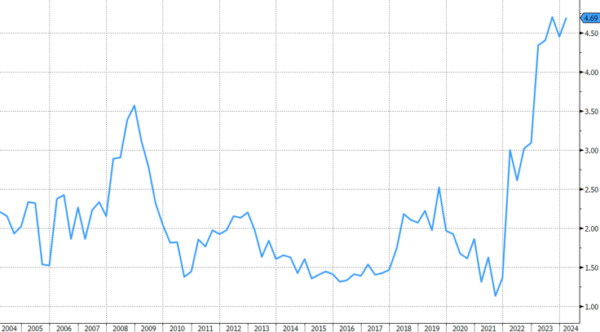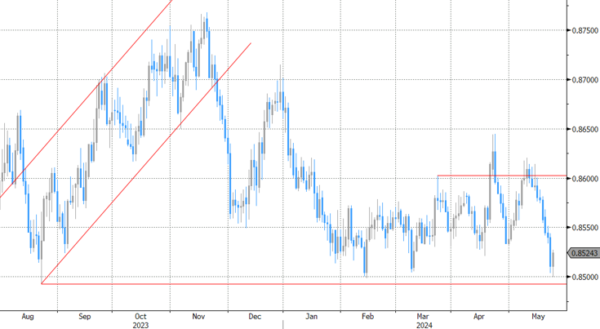Markets
European May PMIs were generally speaking good. The services reading stabilized at a decent 53.3 in May but a better-than-expected improvement in the admittedly still struggling manufacturing sector (from 45.7 to 47.4) lifted the composite figure to the highest in a year (52.3). S&P Global estimates Q2 growth at 0.3% while projecting an annual 1% growth (with upside) risks for 2024. Faster increases in private sector business activity, new orders and employment were recorded. Services continued to compensate for manufacturing in every of the aforementioned components. That said, the rate of contraction in manufacturing output (nearing stabilization) and new orders was the slowest since long. Business confidence hit a 27-month high. Meanwhile, rates of inflation of both input costs and output prices softened from April. That’s little reason to cheer though as they remained above pre-pandemic averages in each case. In addition, the widely anticipated outcome of the Q1 negotiated wages defied expectations for a decline and instead picked up from 4.5% to 4.7%. That matched the 2023Q3 three-decade high. The ECB, among those anticipating a slowdown as well, did its best to downplay the result in a blog post. They attributed it to (German) one-offs and said that based on a range of indicators, including its own tracker, wage growth would decelerate in 2024 from current elevated levels. Be that as it may, ECB policymakers themselves have highlighted the importance of today’s outcome for future policy (after a June cut) numerous times and it’s all too easy to be splitting hairs afterwards. German Bunds naturally underperform US Treasuries today. Yields in the country rise up to 6.2 bps at the front with the 2-yr yield hitting new YtD highs. The European swap counterpart is coming close. Money markets pared conviction on three ECB rate cuts this year to less than 50%. US rates in choppy trading trade flat to slightly higher (+/- 1bp) after another strong weekly jobless claims reading (215k vs 220k expected) erased earlier (small) losses. Gilt yields initially extended yesterday’s CPI driven surge before reversing course following the PMIs (see below). They currently trade 0.4-1.2 bps lower.
The euro takes the upper hand against the dollar, bringing the EUR/USD pair from 1.0823 to 1.086 currently. Technically nothing has changed though with first resistance levels at 1.0895 never having come under pressure. The common currency also got some respite against the British pound. EUR/GBP rebounded from an important support level around 0.85 to change hands in the 0.852 area with the move gaining traction after the UK PMIs. Equity markets trade in positive territory, helped by stellar Nvidia results released yesterday after US trading hours. The EuroStoxx50 adds 0.5%, Wall Street opens with about 1% gains for the Nasdaq.
News & Views
The Turkish central bank (CBRT) kept its policy rate unchanged at 50% and sticks with a tightening bias in case a significant and persistent deterioration in inflation is foreseen. Recent indicators point to a slowdown in domestic demand compared to Q1 2024. In addition to the high level of and the stickiness in services inflation, inflation expectations, geopolitical risks, and food prices keep inflationary pressures alive. Considering the lagged effects of the monetary tightening, the Committee decided to keep the policy rate unchanged, but reiterated that it remains highly attentive to those inflation risks. The Turkish lira keeps near historically low levels around EUR/TRY 35.
The UK Composite PMI unexpectedly declined from 54.1 to 52.8 in May while consensus was looking for a stabilization. A revival in manufacturing production (51.3 from 49.1; 22-month high) couldn’t make up for a setback in services (52.9 from 55; 6-month low). Business activity growth was again accompanied by a rise in new order volumes and an uptick in export sales, but ongoing hiring challenges meant that the rate of job creation remained only marginal. At the same time, UK businesses reported the softest increase in average selling prices for over three years, partly linked to a slowdown in input cost inflation after April’s steep rise. Survey respondents highlighted a softening of labour cost pressures following the increase in the National Living Wage, with services firms especially seeing a drop in input price inflation. Today’s survey data are consistent with GDP rising around 0.3% in Q2.
Graphs
German 2-yr yield hits new YtD high in the wake of improving PMIs and …
… record-matching wage growth in the EMU (2024Q1 data). ECB’s manouvring room after a June cut becomes increasingly limited.
EUR/GBP rebounds after nearing critical support around 0.85. A setback in UK services PMI weighs on sterling.
EUR/CHF nearing parity as scope for rate cuts in Switzerland contrasts with Europe
















